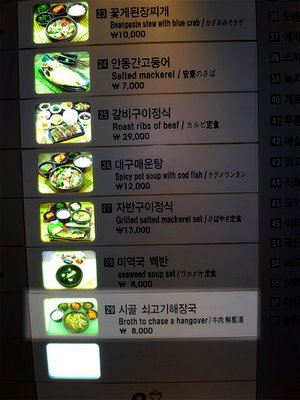山村訓長但知覓
The Sanchon Hunjang(usually clicking on the photos yields an enlarged version)
12/03/2005
Who signs this stuff
The Sanchon Hunjang has been out of town all week, with limited internet access. Unfortunatley the same will be true through Christmas, so it would be best not to expect frequent posts in December.
On the trip out of the country, the Sanchon Hunjang found himself with some spare time at the airport. So I decided to browse the wares up for sale. This is usually an iffy proposition that I usually try to avoid. Best case is that I find nothing of interest, but more likely I run across some stupid (and very expensive) trinket that catches my interest and I put a dent in my wallet for yet another thing I didn't need. Much better to spend that time sitting quietly, book-in-hand.
Anyhow, over at the food court they had this 호박죽 that looked pretty good. Fortunately they were sold out and weren't inclined to make any more. Thank you! It was there that I saw this sign:

I am in the camp that says you can't expect perfect foreign languages on signs. Sure , it would be nice if they would go to the trouble to have a sign checked by a native speaker, especially if it's going to be in a place as frequented by the foreign friends as the airport... But I can accept the fact that the office in charge of sign making doesn't have a big budget. And they have 김사원, who spent 6 months abroad for language study. 김사원 can't very well 'fess up to his boss that he can't even string a few words together in a native way (which, by the way, is a much bigger challenge than it would appear. Try it in Korean sometime...). So it all goes unchecked. I'm okay with that. Sure "Broth To Chasa Hangover" isn't correct, but I get the gist.
But to just leave words as a question mark? "牛肉 解 ? 湯 Beef soup to relieve question marks"?!?!?!? What is that all about? And that in the final product that will be put on public display, no less. What a horrendous blunder!
The really strange thing, though, is that they have the same content on a different sign about a dozen yards away. But on this sign, everything is perfect! It all makes the earlier blunder entirely unforgivable:

On the trip out of the country, the Sanchon Hunjang found himself with some spare time at the airport. So I decided to browse the wares up for sale. This is usually an iffy proposition that I usually try to avoid. Best case is that I find nothing of interest, but more likely I run across some stupid (and very expensive) trinket that catches my interest and I put a dent in my wallet for yet another thing I didn't need. Much better to spend that time sitting quietly, book-in-hand.
Anyhow, over at the food court they had this 호박죽 that looked pretty good. Fortunately they were sold out and weren't inclined to make any more. Thank you! It was there that I saw this sign:

I am in the camp that says you can't expect perfect foreign languages on signs. Sure , it would be nice if they would go to the trouble to have a sign checked by a native speaker, especially if it's going to be in a place as frequented by the foreign friends as the airport... But I can accept the fact that the office in charge of sign making doesn't have a big budget. And they have 김사원, who spent 6 months abroad for language study. 김사원 can't very well 'fess up to his boss that he can't even string a few words together in a native way (which, by the way, is a much bigger challenge than it would appear. Try it in Korean sometime...). So it all goes unchecked. I'm okay with that. Sure "Broth To Chasa Hangover" isn't correct, but I get the gist.
But to just leave words as a question mark? "牛肉 解 ? 湯 Beef soup to relieve question marks"?!?!?!? What is that all about? And that in the final product that will be put on public display, no less. What a horrendous blunder!
☞ 牛: 소 우, 肉: 고기 육, 解: 풀 해, ?: 나 몰를 물음표, 湯: 끓일 탕.
An aside on the subject of using "解" as relieve (as opposed to "cut up" or "break into constituent parts"), there's this curious word for "restroom," especially ones located at Buddhist temples: "解憂所 place for the releiving of cares."
The really strange thing, though, is that they have the same content on a different sign about a dozen yards away. But on this sign, everything is perfect! It all makes the earlier blunder entirely unforgivable:

Archives
7월 2005 8월 2005 9월 2005 10월 2005 11월 2005 12월 2005 1월 2006 2월 2006 3월 2006 7월 2006 8월 2006 10월 2006 4월 2007 5월 2007 6월 2007 7월 2007 8월 2007 9월 2007 10월 2007 11월 2007 12월 2007 1월 2008 5월 2008 8월 2008
